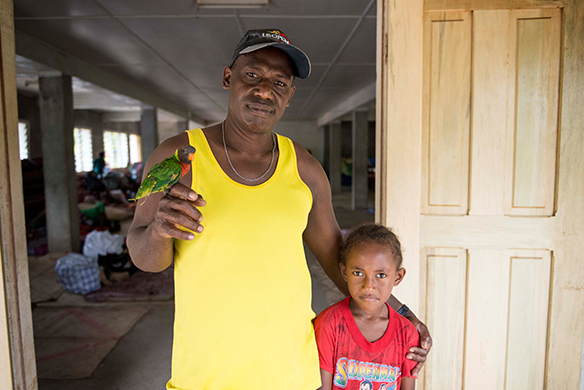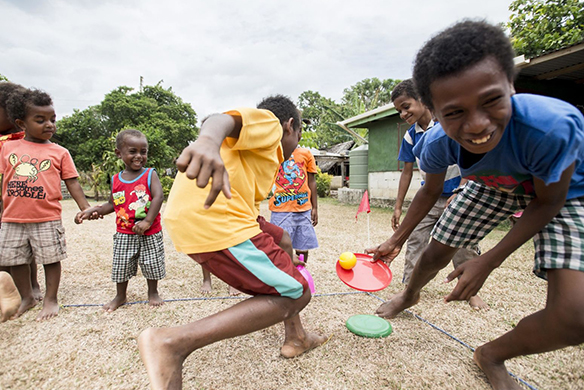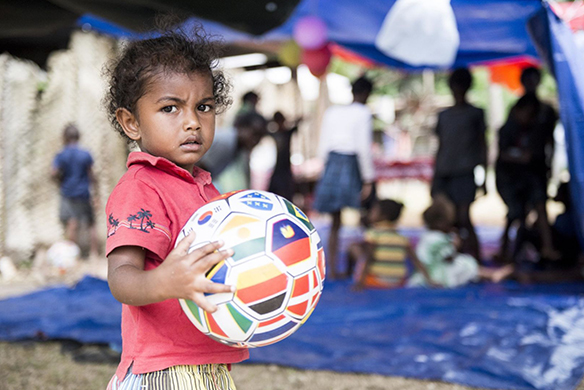Imagine living on a small island dominated by a volcano. What happens when that volcano threatens to erupt?
Right now, the residents of Ambae Island in Vanuatu are finding out.
Luganville is a town on the island of Espiritu Santo in Vanuatu. The main road runs parallel to the ocean and once you’re out of the centre, streets are lush and green, with splashes of pink from flowering bougainvilleas. There is a relaxed and friendly vibe, and people say hello as you walk down the street.
The town has a population of just over 16,000, making it the second biggest in the country. But almost overnight, the population has increased by half.
As you drive in and around the city, you see rows of white tents in grounds of schools and churches. At the end of September, when the volcano on the nearby Ambae Island threatened to blow, a state of emergency was called and every resident was evacuated – now many are in and around Luganville, living in temporary accommodation, waiting until it’s safe to go home.
Imagine your town or suburb no longer being safe to live in and every person having to move somewhere else, living among a community you don’t know. No school, no livelihood, and no way of knowing what’s going on at home.
Vanuatu is one of Australia’s closest neighbours – it takes just 2.5 hours to fly there from Brisbane. But what do you know about the country and its current state of emergency?
Vanuatu is prone to cyclones and volcanoes, and sits on the Ring of Fire, the arc of seismic faults
in the Pacific where earthquakes are common. In fact, of all the countries in the world, Vanuatu is most at risk from natural hazards.
Save the Children has worked in Vanuatu since 1984 and our teams have responded to emergencies here before. In 2015, we helped children and families affected by Cyclone Pam, which damaged and destroyed thousands of homes and schools.

One of the biggest concerns for parents is having their children’s education disrupted, especially with exams coming up in the next couple of weeks. While local schools on Espiritu Santo have been able to accommodate some students, there is simply not enough space for everyone.
Gibson, a teacher from Ambae, explained how they’re doing all they can to keep children playing and learning at an evacuation centre at Bipi Burn Presbyterian Church – and how Save the Children’s Child Friendly Spaces are making a difference. “During the first day we didn’t have anything, tarpaulins or anything, we had nothing,” he says, “we just used what we had, like the shade of the mango tree down there. What we have, we make use of it.”
“But now, things are coming in, so we have resources. We have things we can use to motivate students, especially the little ones.”

Save the Children is setting up Child Friendly Spaces for children at multiple evacuation centres, so they have somewhere to play, spend time with other children and cope with the experience of evacuation.
Volunteer teachers from Ambae are helping us run activities to get kids moving, thinking and working together.
Lidia and Wesley are just two of the children getting support through Save the Children’s Child Friendly Spaces at the evacuation centre at Mango Station. Their mother, Emma, is happy they have the opportunity to play with other kids but is looking forward to returning home. “We miss our island,” she tells us.
In every emergency, Save the Children is looking out for the wellbeing, safety and education of children and these spaces give them a place to go when everything around them is changing.
Save the Children is also working with the government and local partners to make sure children and families stay safe and healthy while they are living in temporary accommodation. We are providing families with hygiene kits that include soap and toothbrushes – and handwashing is an important part of all our Child Friendly Spaces.
If health and hygiene aren’t prioritised in situations like this one, it’s far too easy for sickness to spread and make a difficult situation worse.

Without the big, media-grabbing eruption that people expect of a volcano, it’s easy to underestimate the impact of Ambae’s volcano on people’s lives. But for hundreds of families, life has been put on hold, their livelihoods hang in the balance, and their kids are missing out on education with every day that passes.
Save the Children teams are doing all they can to support children and families who have been evacuated from Ambae. You can make sure we’re always ready to help when children need us by donating to our
Children in Crisis fund.
All images: Rob McKechnie/Save the Children